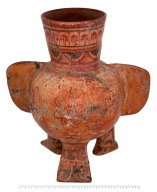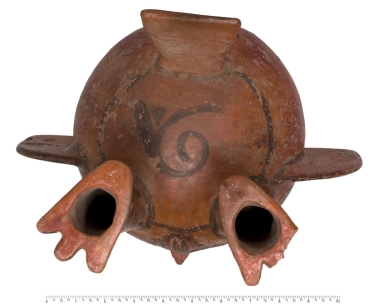Who What Where WhenREMOVE |
REFINE
Browse All : Nahuas--Antiquities
1-18 of 18
Title
Mixtec Pedestal Bowl: Mixcoatl Motif
Description
The Eastern Nahua participated in elaborate gatherings that brought various groups together to cement social and political relationships. Entertainment required story telling, gift giving, eating, and drinking. This beautifully painted pedestal bowl was perhaps a cherished gift used to drink pulque.
Subject
[Ceramic bowls--Mexico--Puebla de Zaragoza, Pottery--Mexico--Puebla de Zaragoza, Nahua art--Mexico--Puebla de Zaragoza, Nahuas--Antiquities, Indigenous Peoples--Antiquities]
Date
between 900 and 1200
Title
Mixtec Pedestal Bowl: Mixcoatl Motif
Description
The Eastern Nahua participated in elaborate gatherings that brought various groups together to cement social and political relationships. Entertainment required story telling, gift giving, eating, and drinking. This beautifully painted pedestal bowl was perhaps a cherished gift used to drink pulque.
Subject
[Ceramic bowls--Mexico--Puebla de Zaragoza, Pottery--Mexico--Puebla de Zaragoza, Nahua art--Mexico--Puebla de Zaragoza, Nahuas--Antiquities, Indigenous Peoples--Antiquities]
Date
between 900 and 1200
Title
Mixtec Pedestal Bowl: Mixcoatl Motif
Description
The Eastern Nahua participated in elaborate gatherings that brought various groups together to cement social and political relationships. Entertainment required story telling, gift giving, eating, and drinking. This beautifully painted pedestal bowl was perhaps a cherished gift used to drink pulque.
Subject
[Ceramic bowls--Mexico--Puebla de Zaragoza, Pottery--Mexico--Puebla de Zaragoza, Nahua art--Mexico--Puebla de Zaragoza, Nahuas--Antiquities, Indigenous Peoples--Antiquities]
Date
between 900 and 1200
Title
Mixtec Pedestal Bowl: Mixcoatl Motif
Description
The Eastern Nahua participated in elaborate gatherings that brought various groups together to cement social and political relationships. Entertainment required story telling, gift giving, eating, and drinking. This beautifully painted pedestal bowl was perhaps a cherished gift used to drink pulque.
Subject
[Ceramic bowls--Mexico--Puebla de Zaragoza, Pottery--Mexico--Puebla de Zaragoza, Nahua art--Mexico--Puebla de Zaragoza, Nahuas--Antiquities, Indigenous Peoples--Antiquities]
Date
between 900 and 1200
Title
Mixtec Pedestal Bowl: Mixcoatl Motif
Description
The Eastern Nahua participated in elaborate gatherings that brought various groups together to cement social and political relationships. Entertainment required story telling, gift giving, eating, and drinking. This beautifully painted pedestal bowl was perhaps a cherished gift used to drink pulque.
Subject
[Ceramic bowls--Mexico--Puebla de Zaragoza, Pottery--Mexico--Puebla de Zaragoza, Nahua art--Mexico--Puebla de Zaragoza, Nahuas--Antiquities, Indigenous Peoples--Antiquities]
Date
between 900 and 1200
Title
Mixtec Pedestal Bowl: Mixcoatl Motif
Description
The Eastern Nahua participated in elaborate gatherings that brought various groups together to cement social and political relationships. Entertainment required story telling, gift giving, eating, and drinking. This beautifully painted pedestal bowl was perhaps a cherished gift used to drink pulque.
Subject
[Ceramic bowls--Mexico--Puebla de Zaragoza, Pottery--Mexico--Puebla de Zaragoza, Nahua art--Mexico--Puebla de Zaragoza, Nahuas--Antiquities, Indigenous Peoples--Antiquities]
Date
between 900 and 1200
Title
Pitcher with two effigy heads : Aztec ewer.
Description
Elaborate twisted hairdo: knotted on top -- possibly female. Concentrations of broken figurines (flat) in household context or debris rather than public buildings or temples suggest a personal or family context. the figurine called "ginger bread" flats, were manufactured by pressing wet clay into clay molds. They were removed for drying, firing, and painting. Fingerprints on the back.
Subject
[Effigy pottery--Mexico--Puebla (State), Ceramic tableware--Mexico--Puebla (State), Indigenous peoples--Antiquities, Nahua art--Mexico--Puebla (State), Nahuas--Antiquities]
Date
between 1250 and 1521
Title
Pitcher with two effigy heads : Aztec ewer.
Description
Elaborate twisted hairdo: knotted on top -- possibly female. Concentrations of broken figurines (flat) in household context or debris rather than public buildings or temples suggest a personal or family context. the figurine called "ginger bread" flats, were manufactured by pressing wet clay into clay molds. They were removed for drying, firing, and painting. Fingerprints on the back.
Subject
[Effigy pottery--Mexico--Puebla (State), Ceramic tableware--Mexico--Puebla (State), Indigenous peoples--Antiquities, Nahua art--Mexico--Puebla (State), Nahuas--Antiquities]
Date
between 1250 and 1521
Title
Pitcher with two effigy heads : Aztec ewer.
Description
Elaborate twisted hairdo: knotted on top -- possibly female. Concentrations of broken figurines (flat) in household context or debris rather than public buildings or temples suggest a personal or family context. the figurine called "ginger bread" flats, were manufactured by pressing wet clay into clay molds. They were removed for drying, firing, and painting. Fingerprints on the back.
Subject
[Effigy pottery--Mexico--Puebla (State), Ceramic tableware--Mexico--Puebla (State), Indigenous peoples--Antiquities, Nahua art--Mexico--Puebla (State), Nahuas--Antiquities]
Date
between 1250 and 1521
Title
Pitcher with two effigy heads : Aztec ewer.
Description
Elaborate twisted hairdo: knotted on top -- possibly female. Concentrations of broken figurines (flat) in household context or debris rather than public buildings or temples suggest a personal or family context. the figurine called "ginger bread" flats, were manufactured by pressing wet clay into clay molds. They were removed for drying, firing, and painting. Fingerprints on the back.
Subject
[Effigy pottery--Mexico--Puebla (State), Ceramic tableware--Mexico--Puebla (State), Indigenous peoples--Antiquities, Nahua art--Mexico--Puebla (State), Nahuas--Antiquities]
Date
between 1250 and 1521
Title
Pitcher with two effigy heads : Aztec ewer.
Description
Elaborate twisted hairdo: knotted on top -- possibly female. Concentrations of broken figurines (flat) in household context or debris rather than public buildings or temples suggest a personal or family context. the figurine called "ginger bread" flats, were manufactured by pressing wet clay into clay molds. They were removed for drying, firing, and painting. Fingerprints on the back.
Subject
[Effigy pottery--Mexico--Puebla (State), Ceramic tableware--Mexico--Puebla (State), Indigenous peoples--Antiquities, Nahua art--Mexico--Puebla (State), Nahuas--Antiquities]
Date
between 1250 and 1521
Title
Pitcher with two effigy heads : Aztec ewer.
Description
Elaborate twisted hairdo: knotted on top -- possibly female. Concentrations of broken figurines (flat) in household context or debris rather than public buildings or temples suggest a personal or family context. the figurine called "ginger bread" flats, were manufactured by pressing wet clay into clay molds. They were removed for drying, firing, and painting. Fingerprints on the back.
Subject
[Effigy pottery--Mexico--Puebla (State), Ceramic tableware--Mexico--Puebla (State), Indigenous peoples--Antiquities, Nahua art--Mexico--Puebla (State), Nahuas--Antiquities]
Date
between 1250 and 1521
Title
Eagle effigy vessel : avian form.
Description
The harpy eagle is the largest bird predator in Mexico and Central America. With power and speed, it is able to fly through the junble canopy and catch a monkey. The Mixtec admired the skills of the harpy eagle and used the eagly as part of their iconography. On this harpy eagle vessel, there are rows of feathers and between some of the rows there are flint blade knives tipped with red blood.
Subject
[Effigy pottery--Mexico--Puebla de Zaragoza, Ceramic tableware--Mexico--Puebla de Zaragoza, Nahuas--Antiquities, Nahua art--Mexico--Puebla de Zaragoza, Indigenous Peoples--Antiquities]
Date
between 1250 and 1521
Title
Eagle effigy vessel : avian form.
Description
The harpy eagle is the largest bird predator in Mexico and Central America. With power and speed, it is able to fly through the junble canopy and catch a monkey. The Mixtec admired the skills of the harpy eagle and used the eagly as part of their iconography. On this harpy eagle vessel, there are rows of feathers and between some of the rows there are flint blade knives tipped with red blood.
Subject
[Effigy pottery--Mexico--Puebla de Zaragoza, Ceramic tableware--Mexico--Puebla de Zaragoza, Nahuas--Antiquities, Nahua art--Mexico--Puebla de Zaragoza, Indigenous Peoples--Antiquities]
Date
between 1250 and 1521
Title
Eagle effigy vessel : avian form.
Description
The harpy eagle is the largest bird predator in Mexico and Central America. With power and speed, it is able to fly through the junble canopy and catch a monkey. The Mixtec admired the skills of the harpy eagle and used the eagly as part of their iconography. On this harpy eagle vessel, there are rows of feathers and between some of the rows there are flint blade knives tipped with red blood.
Subject
[Effigy pottery--Mexico--Puebla de Zaragoza, Ceramic tableware--Mexico--Puebla de Zaragoza, Nahuas--Antiquities, Nahua art--Mexico--Puebla de Zaragoza, Indigenous Peoples--Antiquities]
Date
between 1250 and 1521
Title
Eagle effigy vessel : avian form.
Description
The harpy eagle is the largest bird predator in Mexico and Central America. With power and speed, it is able to fly through the junble canopy and catch a monkey. The Mixtec admired the skills of the harpy eagle and used the eagly as part of their iconography. On this harpy eagle vessel, there are rows of feathers and between some of the rows there are flint blade knives tipped with red blood.
Subject
[Effigy pottery--Mexico--Puebla de Zaragoza, Ceramic tableware--Mexico--Puebla de Zaragoza, Nahuas--Antiquities, Nahua art--Mexico--Puebla de Zaragoza, Indigenous Peoples--Antiquities]
Date
between 1250 and 1521
Title
Eagle effigy vessel : avian form.
Description
The harpy eagle is the largest bird predator in Mexico and Central America. With power and speed, it is able to fly through the junble canopy and catch a monkey. The Mixtec admired the skills of the harpy eagle and used the eagly as part of their iconography. On this harpy eagle vessel, there are rows of feathers and between some of the rows there are flint blade knives tipped with red blood.
Subject
[Effigy pottery--Mexico--Puebla de Zaragoza, Ceramic tableware--Mexico--Puebla de Zaragoza, Nahuas--Antiquities, Nahua art--Mexico--Puebla de Zaragoza, Indigenous Peoples--Antiquities]
Date
between 1250 and 1521
Title
Eagle effigy vessel : avian form.
Description
The harpy eagle is the largest bird predator in Mexico and Central America. With power and speed, it is able to fly through the junble canopy and catch a monkey. The Mixtec admired the skills of the harpy eagle and used the eagly as part of their iconography. On this harpy eagle vessel, there are rows of feathers and between some of the rows there are flint blade knives tipped with red blood.
Subject
[Effigy pottery--Mexico--Puebla de Zaragoza, Ceramic tableware--Mexico--Puebla de Zaragoza, Nahuas--Antiquities, Nahua art--Mexico--Puebla de Zaragoza, Indigenous Peoples--Antiquities]
Date
between 1250 and 1521
1-18 of 18
|

















